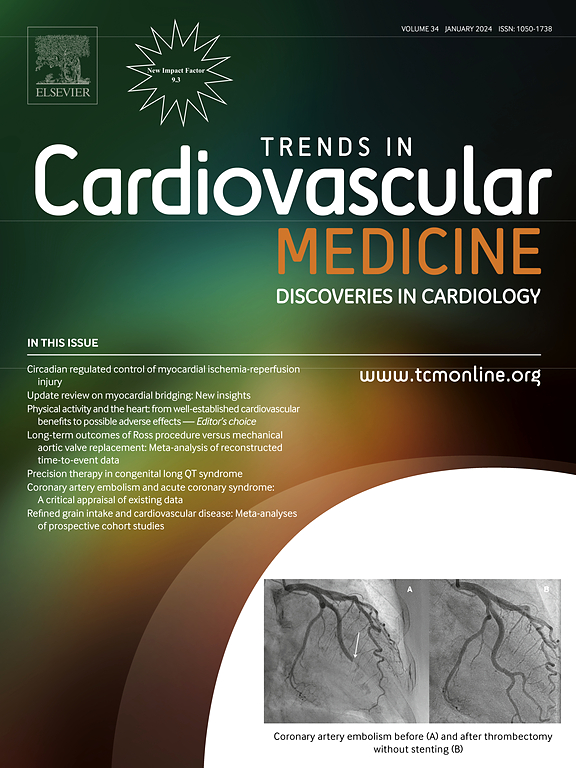心绞痛的处理。
IF 9
2区 医学
Q1 CARDIAC & CARDIOVASCULAR SYSTEMS
引用次数: 0
摘要
心绞痛是缺血性心脏病的主要表现,在全球范围内造成了重大的临床和经济负担。本文综述了心绞痛治疗的最新进展,强调以患者为中心,结合药理学、介入治疗和生活方式策略来降低心血管风险和改善患者预后。对于阻塞性冠状动脉疾病,最佳的药物治疗是治疗的基石。个体化治疗方案应根据血压、心率、左心室功能、心力衰竭和糖尿病等合并症、伴随用药、患者偏好和药物可用性等临床因素量身定制。心肌血运重建术保留用于特定病例,以缓解症状或改善预后。对于伴有非阻塞性冠状动脉(ANOCA/INOCA)的心绞痛或缺血,精确的内型分类,区分微血管型心绞痛、血管痉挛性心绞痛、混合型和非冠状动脉胸痛,可以实现个性化的治疗策略。生活方式干预,包括戒烟、体重管理、坚持地中海饮食和运动疗法,是护理的基本组成部分,可促进心血管结局和生活质量的改善。有组织的锻炼计划,特别是在心脏康复环境中,已被证明在增强功能能力和减少不良事件方面有效。新兴疗法,包括药物和新型介入方法,如冠状动脉窦减速器,有望解决难治性心绞痛和具有挑战性的ANOCA/INOCA病例的未满足需求。未来的方向应优先考虑精准医学、数字健康技术和多学科护理的整合,以优化结果和推进个性化心绞痛管理。本文章由计算机程序翻译,如有差异,请以英文原文为准。
Management of angina pectoris
Angina pectoris, a primary manifestation of ischemic heart disease, imposes a significant clinical and economic burden globally. This review highlights recent advancements in the management of angina, emphasizing a patient-centred approach that integrates pharmacological, interventional, and lifestyle strategies to reduce cardiovascular risk and improve patient outcomes. For obstructive coronary artery disease, optimal medical therapy represents the cornerstone of treatment. Individualized regimens should be tailored to clinical factors such as blood pressure, heart rate, left ventricular function, comorbidities like heart failure and diabetes, concomitant medications, patient preferences, and drug availability. Myocardial revascularization is reserved for select cases to alleviate symptoms or improve prognosis. For angina or ischemia with non-obstructive coronary arteries (ANOCA/INOCA), precise endotype classification, differentiating microvascular angina, vasospastic angina, mixed type and non-coronary chest pain, enables personalized treatment strategies. Lifestyle interventions, including smoking cessation, weight management, adherence to Mediterranean diet, and exercise therapy, are essential components of care, promoting improved cardiovascular outcomes and quality of life. Structured exercise programs, particularly within cardiac rehabilitation settings, have demonstrated efficacy in enhancing functional capacity and reducing adverse events. Emerging therapies, including pharmacological agents and novel interventional approaches such as the coronary sinus reducer, hold promise for addressing unmet needs in refractory angina and challenging ANOCA/INOCA cases. Future directions should prioritize the integration of precision medicine, digital health technologies, and multidisciplinary care to optimize outcomes and advance personalized angina management.
求助全文
通过发布文献求助,成功后即可免费获取论文全文。
去求助
来源期刊

Trends in Cardiovascular Medicine
医学-心血管系统
CiteScore
18.70
自引率
2.20%
发文量
143
审稿时长
21 days
期刊介绍:
Trends in Cardiovascular Medicine delivers comprehensive, state-of-the-art reviews of scientific advancements in cardiovascular medicine, penned and scrutinized by internationally renowned experts. The articles provide authoritative insights into various topics, encompassing basic mechanisms, diagnosis, treatment, and prognosis of heart and blood vessel disorders, catering to clinicians and basic scientists alike. The journal covers a wide spectrum of cardiology, offering profound insights into aspects ranging from arrhythmias to vasculopathies.
 求助内容:
求助内容: 应助结果提醒方式:
应助结果提醒方式:


